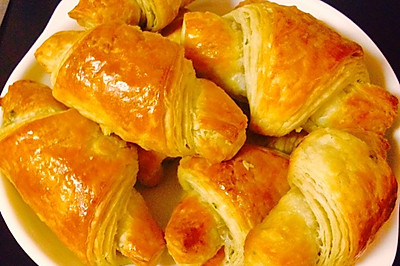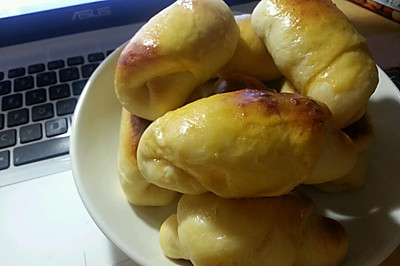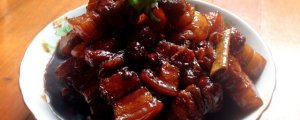
Croissant (home version of hand crisp) [no privacy]
(159479 views)![Croissant (home version of hand crisp) [no privacy]](https://cp1.douguo.com/upload/caiku/3/8/f/yuan_38ba575dacea2e73e90a06985fc6224f.jpg)
For food, for profession, for faith, there are always people who are not afraid of the cold. The iceberg is also split. And tens of thousands of baking lovers, when the cold winter comes, will rush to tell each other that the season of crisp is coming again. It's better to control the room temperature at 20 ℃ ~ 22 ℃ for shortening. Once the safety range is exceeded, the butter may exceed the melting point under the influence of various factors in the production process. During the rolling process of the dough, it is easy to become wet, stick and break the skin. The operation is limited. The finished product is naturally affected. At the same time, the pastry needs to be fermented slowly at a lower temperature, generally lower than 25 ℃ for 12 hours. If the fermentation temperature is too high, the pastry is prone to oil leakage. If the fermentation temperature is too low, it will take a long time to ferment. It will also affect the state of dough.
Cooking ingredients
Cooking Steps

Step1:All materials except butter. Mix and stir until the surface is smooth. There is rough serration.

Step2:The surface temperature shall be controlled at 2324 ℃. The room temperature shall be about 24 ℃ and fermented for 30 minutes, and then put into the refrigerator for refrigeration overnight.

Step3:Refrigerate the dough overnight.

Step4:Roll it out to 20 * 30cm.

Step5:Tidy it up by hand.

Step6:You can use your hands to help organize the four corners.

Step7:Refrigerate.

Step8:250g butter is wrapped with oil paper and beaten with a rolling pin until it is extended (the frozen butter is hard, and the beaten butter will be easier to roll out). Roll it out into a rectangle of 15 * 20cm, and refrigerate it in the refrigerator until it is the same as the dough hardness.

Step9:Start to open the pastry. Fold it for the first time. Put the butter on the horizontal pasta vertically.

Step10:Fold both sides of the patch to the middle. Pinch the patch at the seam.

Step11:Side cutting. Cut the whole side of the patch (the function of cutting - to prevent the space in the fold position of the innermost patch after folding).

Step12:The above figure is the section diagram of the first four fold back side cuttin

Step13:Then press the dough with a rolling pin to spread the butter before rolling.

Step14:Roll the patch to a thickness of about 7mm.

Step15:First fold the right half.

Step16:Fold up the left 4 / 5. The left and right folds are next to each other.

Step17:Fold the dough in half again. The first four fold is finished.

Step18:Cut the side of the dough. Then refrigerate for 30 minutes.

Step19:Take out the frozen dough, roll it out and fold it.

Step20:The second four fold operation is the same as the first four fold operation.

Step21:Same side cut.

Step22:Refrigerate for 30 minutes to 1 hour.

Step23:Take out the refrigerated dough and roll it until it is 45mm thick. Relax at room temperature for 30 minutes.

Step24:Then cut it to 14 * 7 cm in height and width. The ratio of height and width is 2-1. It can be frozen for 3 days if it is not used up. Before use, it can be cut and used after thawing a little.

Step25:Cut into isosceles.

Step26:Start from the bottom of the triangle and gently roll it up into a spindle shape.

Step27:Press the tail down slightly (don't roll too tight).

Step28:Start fermentation. The temperature is 25~28 ℃. The humidity is 7075%. fermentation for 23 hours. When it is sent to the two sides, gently knead them with your hands. You can feel that there is no obvious elasticity..

Step29:Air oven 190 ℃ baking 1

Step30:
Cooking tips:① the hardness of the wrapped butter and the surface shall be the same. ② After wrapping the butter, press it with a rolling pin to extend the oil before rolling it out. ③ Fold the back side of the knife and then roll it out. ④ Before the final cutting, it should be fully relaxed. Otherwise, the cutting back will deform the thick rolling pin for easy operation. ⑤ The formula uses presidential butter with low melting point, so the fermentation temperature of the whole dough cannot exceed 28 ℃. ⑥ It is suggested to use a rolling pin with a thick roller, which can control the force better and exert force better when rolling. It is recommended to use wooden rolling pin when the temperature is low in winter. Do not use marble. Marble is too cold in winter. It is not easy for butter to roll out when it is cold. It is the opposite in summer or when the temperature is high. ⑦ The specific operation of four fold - put the butter in the middle of the dough. Fold the two sides of the dough in the middle and then tighten the joint. Roll out the butter dough and roll it long. Fold up the right 1 / 5 of the dough. Fold up the left 4 / 5 of the dough. The left and right folds are next to each other. Fold the dough in half. Four fold is finished. Delicious cooking
 Chinese Food
Chinese Food












